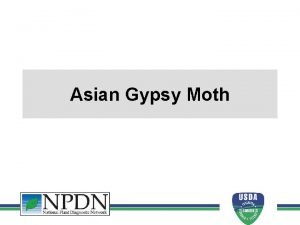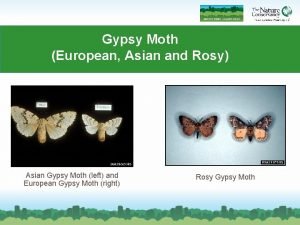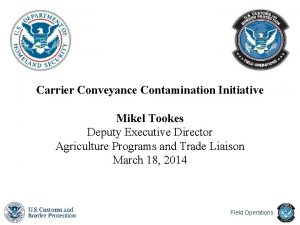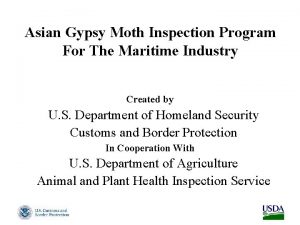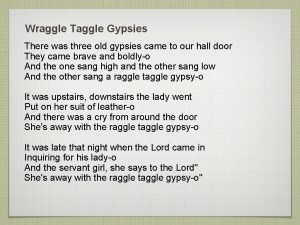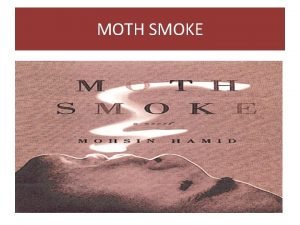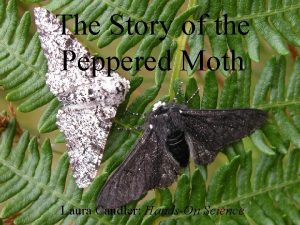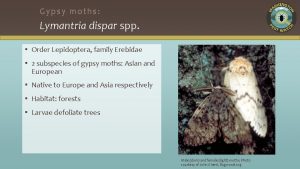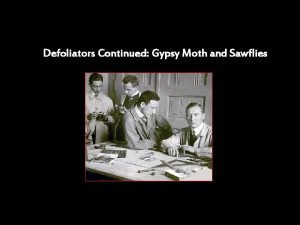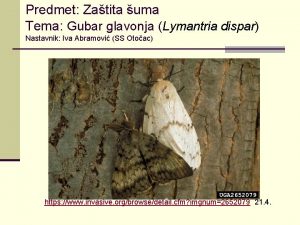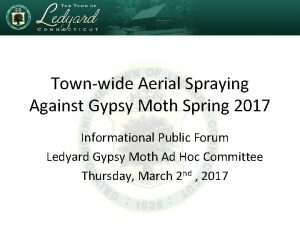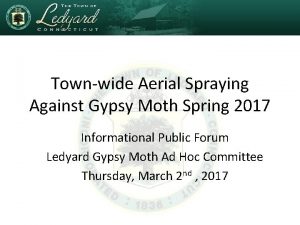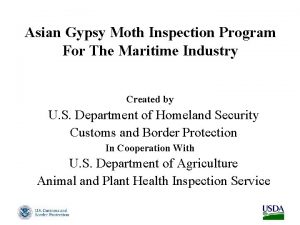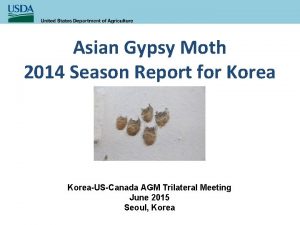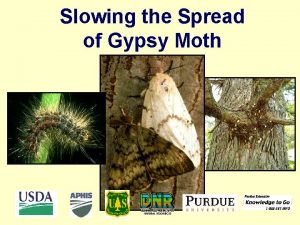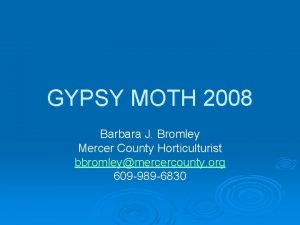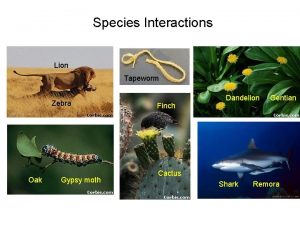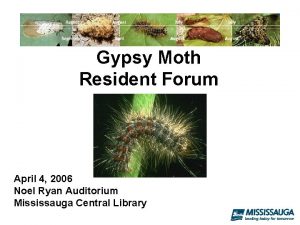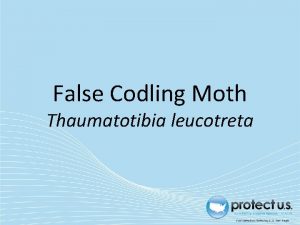Gypsy Moth Lymantria dispar Most destructive defoliating insect
































- Slides: 32

Gypsy Moth - Lymantria dispar • Most destructive defoliating insect in North America • Kills Conifers and Hardwoods • Nuisance in urban areas • Cause medical problems as some allergic to “hairs” • Introduced insect pest • Billions of dollars has been spent on this creature • One of the “Big Bug” research areas • Eventually will be in Georgia & Alabama

Trouvolet and Introduction video

Spread 1965 1900 1934 1995

Mountain Side Defoliated by Gypsy moths

Gypsy Moth Life Cycle

Adult males emerge in June – July and locate females using pheromones. Note feathery antennae of male

Gypsy Moth Females and Egg Masses on Tree Trunk

Female lay egg masses on tree trunks or other vertical objects. An egg mass contains 100 – 1500 eggs which are the overwintering stage.

Eggs hatch the following spring. Gypsy Moth first instar larvae

Larvae emerge in Mid. April and disperse by “ballooning” Have very long “hairs” are easily airborne

Instars 4 -6 feed on new foliage first and then move on to older foliage if necessary

Mature Gypsy Moth larvae are large insects and one can eat several leaves a day.

Gypsy Moths often pupate on tree trunks. Pupae are found in June and July which lasts about 2 weeks. Pupal case

• Adults emerge, find each other and the cycle continues. • One generation per year. • Females do not FLY.

Gypsy Moth Ecology

Management Considerations Natural enemies Parastoids: Pathogens: Predators: Climate:

Ant attacking Gypsy Moth Pupa

White footed mice eating Gypsy Moths

Diptera Parasitoid on egg masses

Gypsy Moth Video

Management Considerations


Alabama Gypsy Moth Survey Program Part of USDA Forest Services “Slow the Spread” Program Cooperative effort between USDA/APHIS, Auburn University & Alabama Extension Service

Gypsy Moth: Slow the Spread Program Expectations: • 1) • 2) • 3)

Slow the Spread has three main thrusts Trapping—Officials monitor gypsy moth populations by placing a grid of pheromone-baited traps to allow early detection in of the moth in new areas. Suppression— Reduce populations using various options including 1) mating disruption with pheromone flakes, 2) mass trapping; 3) releases of sterile insects; 4) spraying with Bacillus thuringiensis (Bt), diflubenzuron (disrupts development) or the NPV virus Gypchek®. Regulatory Work —Human movement of infested articles is a major factor in spread. Regulatory actions to reduce such movement will be enforced.

Pheromone Trap and dispensers

Gypsy Moth captures – 2000 • Jefferson • Winston • Morgan

Gypsy Moth captures – 2001 • Cleburne • Barbour • Butler

Gypsy Moth captures – 2002 • Limestone • Winston • Greene • Dallas • Tuscaloosa

Gypsy Moth captures – 2003 • Lauderdale

Gypsy Moth captures – 2004 • Madison • Blount • Calhoun

End of Gypsy Moth Section
 Gypsy moth caterpillar
Gypsy moth caterpillar Gypsy moth population
Gypsy moth population Gypsy moth
Gypsy moth Gypsy moth caterpillar
Gypsy moth caterpillar Asian gypsy moth vessel inspection
Asian gypsy moth vessel inspection Asian gypsy moth inspection
Asian gypsy moth inspection Wraggle taggle gypsy
Wraggle taggle gypsy English xxx pussy
English xxx pussy River gypsy in bangladesh class 8
River gypsy in bangladesh class 8 Ii. the gipsy (magna), 2008
Ii. the gipsy (magna), 2008 The sleeping gypsy analysis
The sleeping gypsy analysis Jeopardy gypsy answer
Jeopardy gypsy answer Scholar and gypsy by anita desai summary
Scholar and gypsy by anita desai summary Travellers surrey
Travellers surrey Gypsy ballads
Gypsy ballads River gypsy
River gypsy Hristo kyuchukov
Hristo kyuchukov Moth food chain
Moth food chain Moth smoke summary
Moth smoke summary Peppered moth
Peppered moth Kern primrose sphinx moth
Kern primrose sphinx moth Moth
Moth Duponchelia fovealis
Duponchelia fovealis Oak processionary moth life cycle
Oak processionary moth life cycle Food chain of beetle aphid bird
Food chain of beetle aphid bird Pathfinder black butterfly
Pathfinder black butterfly Morgan sphinx moth
Morgan sphinx moth Geologic time scale drawing
Geologic time scale drawing Ethereal moth wikipedia
Ethereal moth wikipedia Carle very quiet cricket download
Carle very quiet cricket download Peppered moth story
Peppered moth story Insect resurgence
Insect resurgence Karilased
Karilased
